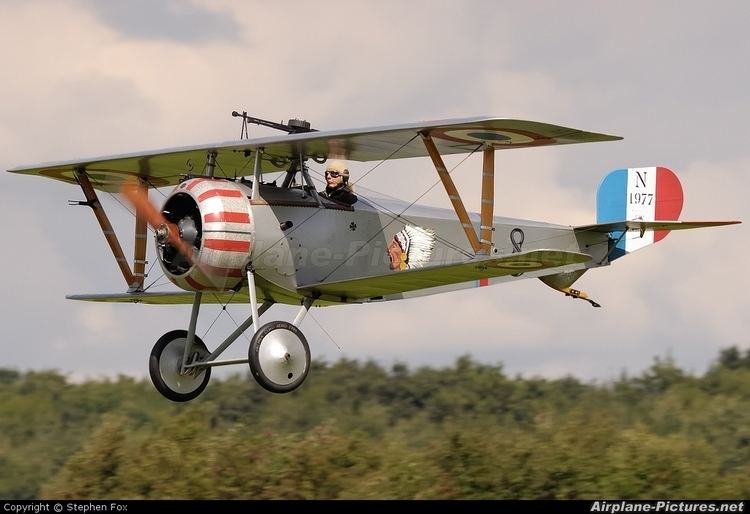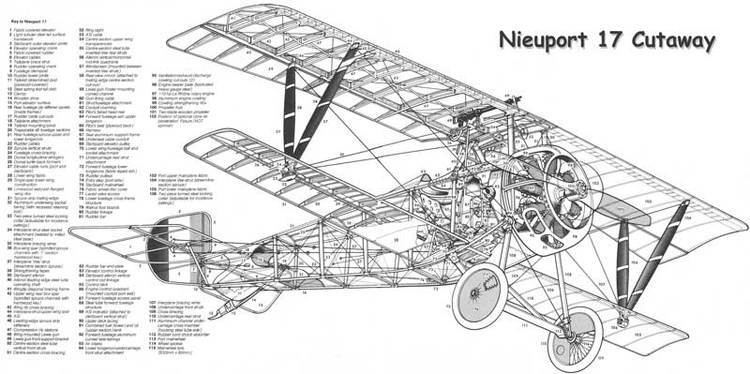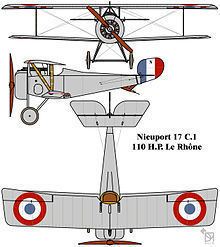Top speed 177 km/h Range 250 km Weight 375 kg First flight January 1916 | Length 5.8 m Wingspan 8.15 m | |
 | ||
The Nieuport 17 C.1 was a World War I French sesquiplane fighter designed by the Nieuport company. Its outstanding maneuverability and excellent rate of climb gave it a significant advantage when it entered service over all other fighters on both sides and as a result was widely used and enjoyed substantial production runs in France, Italy (Nieuport-Macchi) and Russia (Dux), eventually being used by every Allied power, and even being copied in Germany.
Contents
- Rise of flight introduction to the nieuport 17 c1 gbr halberstadt d ii
- Design and development
- Operational history
- Copies
- Variants
- Survivors and replicas
- Operators
- Specifications Nie 17
- References

Rise of flight introduction to the nieuport 17 c1 gbr halberstadt d ii
Design and development
The Nieuport 17 was a slightly larger development of the earlier Nieuport 11, trimmed for the heavier powerplant used by the Nieuport 16 and with a larger wings and improved aerodynamic form. It was at first fitted with a 110 hp (82 kW) Le Rhône 9J engine, though later examples used uprated 120 or 130 hp (97 kW) engines.

Production of the new Alkan-Hamy synchronization gear permitted the wing mounted Lewis gun of the "11" to be replaced with a synchronised Vickers gun mounted on the fuselage to fire through the propeller. The standard Royal Flying Corps synchroniser, the Vickers-Challenger gear, was unreliable, and in British service the over-wing Lewis gun was retained, mostly on the new Foster mounting, a curved metal rail which allowed the pilot to slide the gun back to change drums or clear jams. Some aircraft, particularly French, were fitted with both guns but a single machine gun was most common.

The Nieuport 21 differed in primarily using the lower powered 80 hp Le Rhône 9C and was intended as a fighter trainer or high altitude bomber escort, however it was used alongside the Nieuport 17 in the normal fighter roles in French and Russian service.
The Nieuport 23 differed from the 17 in only minor details, primarily centered around the use of a different machine gun synchronizer — which caused the gun to be offset and the fuel and oil tanks to be rearranged. Rear spar packing pieces were also redesigned. In service use, they were operated by both French and British squadrons alongside Nieuport 17s until replaced by Nieuport 24s.
Two triplanes based on the Nieuport 17 were built, one for testing by the French and the other by the British. The narrow chord wings were staggered in an unusual manner, with the middle wing furthest forward and the top wing furthest aft. No orders resulted, although Nieuport trialed the same layout on a Nieuport 17bis which was tested by the British as well, with no more success. Both types had good climbing characteristics but were tail heavy.
The narrow, single-spar lower wing which made the Nieuport 17 a sesquiplane (literally "one-and-a-half plane"), and helped give it an impressive climb rate, was liable to flutter (a phenomenon not fully understood at the time). Several Nieuport fighters did indeed suffer catastrophic lower wings failure, especially during recovery from a prolonged dive. British Nieuports were strengthened with modifications at No 2 Aeroplane Supply Depot, while training, and replacing the lower wings with those from Nieuport 24s at French squadrons helped reduce the danger.
Several Berliner Helicopters were built around Nieuport 23 fuselages including the 1922 and 1923 versions.
Operational history
The new type reached the French front in March 1916 and quickly replaced the earlier Nieuport 11 and 16 fighters in French service that had been instrumental in ending the Fokker Scourge of 1915. The Nieuport 17 entered service with Escadrille N.57 on May 2, 1916. Almost all of the top French aces used the nimble Nieuport during their career including Georges Guynemer, Charles Nungesser, Maurice Boyau, Armand Pinsard, René Dorme, Gabriel Guerin and Alfred Duellin. The type was also used by American volunteers of the Escadrille Lafayette when they replaced their earlier Nieuport 11s and 16s. During the latter part of 1916 and into 1917 the Nieuport 17 equipped every fighter squadron of the Aéronautique Militaire. Charles Nungesser scored most of his victories while flying Nieuports.
It was also ordered by the Royal Flying Corps and Royal Naval Air Service, as it was markedly superior to all British fighters available during most of its period of front line service. The RFC in particular still had large numbers of obsolete Airco DH.2s in service nearly a year later when it incurred severe losses during Bloody April. While the majority of aircraft lost were obsolete observation aircraft such as the Royal Aircraft Factory B.E.2, the Nieuports had begun to lose their decisive advantage and took losses as well. British squadrons that used the type include Nos 1, 29, 32, 40 and 60 of the Royal Flying Corps and No 6 of the Royal Naval Air Service. During the Battle of Arras much use was made of British Nieuports in balloon-busting attacks to prevent enemy artillery spotting. No 40 Squadron experimented with low level hedge-hopping attacks to reach the balloons while Nieuports of No 60 Squadron co-operated with F.E. 2bs of No 11 Squadron to carry out massed strafing attacks on German infantry entrenched on both sides of the River Scarpe.
By mid-1917, the Nieuport was losing its superiority over German types such as the new Albatros D.III. The more powerful, 130 HP (95.6 kW) Clerget 9B nine-cylinder rotary engine, along with aerodynamic refinements such as stringers fairing out the fuselage sides resulted in the Nieuport 17bis which was produced in very small numbers. Further refinement and a switch to more powerful and lighter Le Rhône rotaries resulted in the Nieuport 24 and the 27 which gradually replaced the 17s, 21s and 23s in service while the 150 hp SPAD S.VII had begun replacing the older Nieuport fighters in French front line squadrons by mid-1917. The British retained their Nieuports until early 1918.
Many British Empire air aces flew Nieuport fighters, including top Canadian ace Billy Bishop, who received a Victoria Cross while flying it, and Albert Ball, V.C. who often hunted alone in his Nieuport. 'Mick' Mannock VC flew Nieuports early in his career with No 40 Squadron. His VC award reflected his whole combat career - including his time on Nieuports. The top-scoring Nieuport ace was Captain Phillip Fletcher Fullard of No.1 Squadron RFC, who scored 40 kills between May and October 1917, before breaking his leg in a football match.
Italian aces such as Francesco Baracca, Silvio Scaroni and Pier Piccio all achieved victories while flying Nieuport fighters. In Belgium the 1st and 5th Belgian escadrilles were equipped with the Nieuport 17. Belgian aces flying the type included Andre de Meulemeester, Edmond Thieffry and Jan Olieslagers. Imperial Russian forces operated large numbers of Nieuports of all types including the Nieuport 17, 21 and 23, with many continuing in service after the Russian Revolution with the Soviet Union. Russian Nieuport aces include Alexander Kazakov.
Like other Nieuport types, the 17 was used in large numbers as an advanced trainer after its operational days were over. The American Expeditionary Forces purchased 75 Nieuport 17s for training while the French also operated large numbers as trainers.
The French Aviation Maritime used several Nieuport 21s for deck landing training in 1920 pending the delivery of dedicated carrier aircraft such as the Nieuport-Delage NiD.32RH.
Copies
The Germans requested their own aircraft manufacturers to copy the Nieuport and examples as well as drawings were provided. This resulted in the Siemens-Schuckert D.I which differed primarily in some minor details, and it saw service, although in the event it was not widely used operationally as by then other designs had surpassed it. The Euler D.I was also a copy, although it did not proceed beyond a few prototypes. Rather than make a slavish copy, Albatros Flugzeugwerke adopted the sesquiplane wing structure for the Albatros D.III and D.V which were called 'V-strutters' by the RFC to distinguish them from the earlier Albatros D.II. The German machines were heavier than the Nieuport which aggravated the design flaw that led to the wing failures which a few Nieuports had experienced. Despite extra bracing from the vee strut to the lower wing, the Germans never solved the problem. Pfalz was also inspired by the Nieuport, and developed the Pfalz D.III, a sesquiplane version of a previous biplane fighter, although they built a more substantial lower wing with two spars that avoided Albatros's problems.
Variants
Survivors and replicas
A single original example survives, Nieuport 23 "5024" in the Belgian Royal Museum of the Armed Forces and Military History in Brussels, however it is also a popular aircraft for replica builders, with kits being produced, including both 7/8ths scale and full size, and groups of builders have built entire squadrons. Original drawings, both from the factory and a German technical report have facilitated the construction of replicas such as the example on display in the Canadian War Museum in Ottawa, Ontario, built to original specifications, while others use more modern construction with metal tubes replacing much of the wooden structure.
Operators
operated at least five Nieuport 17s and three Nieuport 21s
Specifications (Nie 17)
Data from Those Classic Nieuports
General characteristics
Performance
Armament
Avionics
